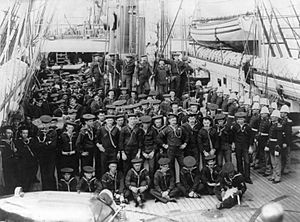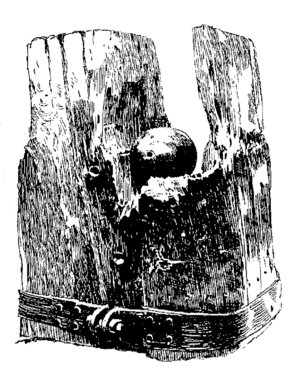USS Kearsarge (1861) facts for kids
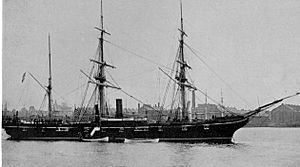 |
|
Quick facts for kids History |
|
|---|---|
| Name | USS Kearsarge |
| Namesake | Mount Kearsarge, later ones are named in honor of her. |
| Ordered | 1861 |
| Builder | Portsmouth Navy Yard, Kittery, Maine |
| Laid down | 1861 |
| Launched | 11 September 1861 |
| Commissioned | 24 January 1862 |
| Decommissioned | 26 November 1864 |
| Recommissioned | 1 April 1865 |
| Decommissioned | 14 August 1866 |
| Recommissioned | 16 January 1868 |
| Decommissioned | 11 October 1870 |
| Recommissioned | 8 December 1873 |
| Decommissioned | 15 January 1878 |
| Recommissioned | 15 May 1879 |
| Decommissioned | 1 December 1886 |
| Recommissioned | 2 November 1888 |
| Stricken | 1894 |
| Fate | Wrecked, 2 February 1894 |
| General characteristics | |
| Type | Sloop-of-war |
| Displacement | 1,550 long tons (1,570 t) |
| Length | 201 ft 3 in (61.34 m) |
| Beam | 33 ft 8 in (10.26 m) |
| Draft | 14 ft 3 in (4.34 m) |
| Propulsion | Steam engine/Sails |
| Speed | 11 kn (13 mph; 20 km/h) |
| Armament | 2 × 11 in (280 mm) smoothbore Dahlgren guns, 4 × 32-pounder guns, 1 × 30-pounder Parrott rifle |
The USS Kearsarge was a special kind of warship called a sloop-of-war. She is most famous for defeating the CSS Alabama, a Confederate ship that attacked merchant ships. This big battle happened off the coast of Cherbourg, France, during the American Civil War. The Kearsarge was the only ship in the United States Navy named after Mount Kearsarge in New Hampshire. Later, other ships were named Kearsarge to honor her.
Contents
Building a Warship: The Kearsarge Story
The Kearsarge was built at the Portsmouth Naval Shipyard in Kittery, Maine. This was part of a quick shipbuilding plan during the 1861 American Civil War. This new steam-powered sloop-of-war weighed about 1,550 tons. She was launched on September 11, 1861. Mrs. McFarland, whose husband edited the Concord Statement, sponsored the ship. The Kearsarge officially joined the Navy on January 24, 1862. Captain Charles W. Pickering was her first commander. Soon after, she began her mission to hunt for Confederate ships in European waters.
Hunting Down Confederate Raiders
The Kearsarge left Portsmouth, New Hampshire on February 5, 1862. Her first stop was the coast of Spain. She then sailed to Gibraltar to help block the Confederate ship CSS Sumter. This forced the Sumter to be abandoned there in December 1862. However, the Sumter's captain, Raphael Semmes, went back to England. He soon got a new ship, the British sloop Enrica. He renamed it CSS Alabama off the Azores, in international waters. The Alabama then became one of the most successful ships at attacking merchant vessels in history.
From November 1862 to March 1863, the Kearsarge got ready to face the Alabama. She searched for the raider all along the coast of Northern Europe. Her search took her to the Canary Islands, Madeira, and the Outer Hebrides. In early May 1864, she ran aground near Oostende. She was repaired in the dry dock of Vlissingen, Netherlands, until May 10. On June 14, 1864, the Kearsarge arrived at Cherbourg. There, she found the Alabama in port. The raider needed repairs after a very long journey across many oceans. She had sunk 65 Union merchant ships. The Kearsarge waited at the harbor entrance for Captain Semmes' next move.
The Famous Battle of Cherbourg
On June 19, the Alabama left Cherbourg Harbor for her final fight. The Kearsarge's new commander, Captain John A. Winslow, moved his ship away from French waters. He then turned to face the Confederate cruiser.
The Alabama fired first. The Kearsarge waited to fire back until she was less than 1,000 yards away. The ships sailed in seven circles, moving southwest. Each captain tried to get in front of the other ship to fire directly at its ends. The battle quickly turned against the Alabama. This was because her gunners weren't very accurate. Also, her gunpowder, fuses, and shells were old and not working well.
What Captain Semmes on the Alabama didn't know was that the Kearsarge had extra protection. She had thick chain cables covering her important machinery. These chains were placed in three layers along the sides of her middle section. This hull armor was added over a year before the battle. It took only three days to install while the Kearsarge was in port at the Azores. It used 720 feet of 1.7-inch iron chain. This covered an area 49 feet 6 inches long and 6 feet 2 inches deep. The chains were held in place by bolts and ropes. They were hidden behind 1-inch wooden boards, painted black to match the ship's hull. This chain armor protected the Kearsarge's engines and boilers. It was especially useful when the ship's coal bunkers were empty.
The armor belt was hit twice during the fight. First, a 32-pound shell from the Alabama hit the chain armor on the starboard side. It cut the chain and dented the hull underneath. A second shell of the same size exploded, breaking a chain link. It also tore away part of the wooden covering. Even if the shells had come from the Alabama's more powerful 100-pound Blakely rifle, the hits were more than 5 feet above the waterline. This means they would have missed the vital machinery anyway.
One hour after firing her first shot, the Alabama was a sinking wreck. This was due to the Kearsarge's more accurate shooting. Her powerful 11-inch Dahlgren smoothbore pivot guns caused great damage. The Alabama sank by her stern soon after. Captain Semmes lowered his flag, showing he surrendered. He threw his sword into the sea so it wouldn't be captured. He sent one of his two remaining small boats to the Kearsarge with a surrender message. He also asked for help for his surviving crew. The Kearsarge sent boats to rescue most of the Alabama's survivors. However, Semmes and 41 others were rescued by the nearby British yacht Deerhound. They escaped to the United Kingdom.
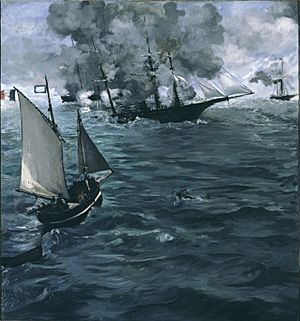
The United States Navy remembers the battle between Kearsarge and Alabama. They honor it with a battle star on the Civil War campaign streamer. Also, 17 crew members from the Kearsarge received the Medal of Honor for their bravery in this battle. These medals were given on December 31, 1864.
- Michael Aheam
- John F. Bickford
- William S. Bond
- James Haley
- Mark G. Ham
- George H. Harrison
- John Hayes
- James H. Lee
- Charles Moore
- Joachim Pease
- Thomas Perry
- William B. Poole
- Charles A. Read
- George E. Read
- James Saunders
- William Smith
- Robert Strahan
After the War: Kearsarge Continues Service
After the battle, the Kearsarge sailed along the French coast. She searched for another Confederate raider, the CSS Florida, but didn't find her. Then, she went to the Caribbean before heading north to Boston, Massachusetts. She was taken out of service for repairs on November 26. She was put back into service four months later on April 1, 1865. On April 14, she sailed to the coast of Spain. Her mission was to stop the Confederate ship CSS Stonewall. However, the Stonewall avoided the Union warships. She surrendered to Spanish authorities in Havana, Cuba, on May 19. After sailing in the Mediterranean Sea and the English Channel, and south to Monrovia, Liberia, the Kearsarge was taken out of service on August 14, 1866, at the Boston Navy Yard.
Post-War Adventures Around the World
The Kearsarge was put back into service on January 16, 1868. She sailed on February 12 to serve in the South Pacific, based out of Valparaíso, Chile. On August 22, she delivered supplies to people in Peru who were suffering from an earthquake. She continued to protect American businesses along the coast of South America until April 17, 1869. Then she sailed to protect American interests in the Marquesas, Society Islands, Navigators Islands, and Fiji Islands. She also visited ports in New South Wales and New Zealand. She returned to Callao, Peru on October 31. She continued her duties in the South Pacific until July 21, 1870. Then she sailed to the Hawaiian Islands. She was taken out of service at the Mare Island Navy Yard on October 11, 1870.
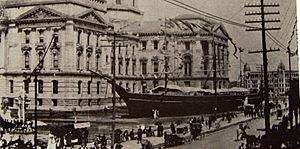
The Kearsarge was put back into service on December 8, 1873. She left on March 4, 1874, for Yokohama, Japan, arriving on May 11. She spent three years on the Asiatic Station. Her job was to protect American citizens and trade in China, Japan, and the Philippines. From September 4 to December 13, she carried Professor Asaph Hall's science team. They traveled from Nagasaki, Japan, to Vladivostok, Russia. Their goal was to observe the transit of Venus. She left Nagasaki on September 3, 1877. She sailed through the Suez Canal, visited Mediterranean ports, and returned to Boston on December 30. She was taken out of service at Portsmouth, New Hampshire on January 15, 1878.
The Kearsarge was put back into service on May 15, 1879. She served for four years in the North Atlantic. Her travels ranged from Newfoundland to the Caribbean Sea and the coast of Panama. The warship took part in the dedication ceremony for the Brooklyn Bridge on May 24, 1883. She left New York on August 21, 1883. For three years, she cruised in the Mediterranean, then Northern European waters, and finally along the west coast of Africa. She returned to Portsmouth on November 12. She was taken out of service at the Portsmouth Navy Yard on December 1, 1886.
The Final Voyage and Wreck
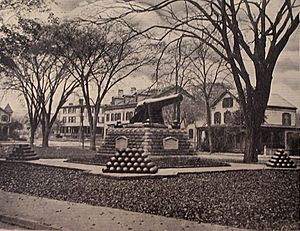
The Kearsarge was put back into service one last time on November 2, 1888. She spent her final years protecting American interests in the West Indies, off Venezuela, and along Central America. In October 1889, she carried the famous abolitionist Frederick Douglass to Haiti. Douglass was going there to be a minister and consul general. On President Harrison's orders, she sailed to Navassa Island in 1891. Her mission was to investigate working conditions there. She left Haiti on January 20, 1894, for Bluefields, Nicaragua. But on February 2, she crashed into a reef off Roncador Cay. All her officers and crew made it safely to shore.
Congress set aside $45,000 to tow the Kearsarge home. However, a salvage team from the Boston Towboat Company found she could not be refloated. Some items were saved from the ship, including the ship's Bible. These salvaged items, along with a damaged part of her stern post, are now stored or displayed at the Washington Navy Yard. This stern post still has an unexploded shell from CSS Alabama stuck in it. According to the US Naval Academy Museum, the shell was removed after the battle. The stern post was then replaced. The Kearsarge was removed from the Naval Vessel Register in 1894.
Kearsarge in Popular Culture
- The play King Cotton by Liverpool writer Jimmy McGovern ends with the battle between Kearsarge and Alabama. It first showed at The Lowry.
- Clive Cussler, an American adventure writer, wrote the 2001 novel Valhalla Rising. In the book, the Kearsarge is attacked by a submerged vessel and runs aground, causing her wreck.
- Harry Turtledove, an American writer of alternate history, wrote the 1992 novel The Guns of the South. In this story, time-traveling South African white nationalists give AK-47 assault rifles to the Confederate States Army in early 1864. This helps the Confederacy win every land battle that year. When Washington is captured, Abraham Lincoln agrees to the Confederacy's independence. The war is implied to end in mid-June. The USS Kearsarge is mentioned as waiting for CSS Alabama to leave Cherbourg when news of the war's end reached Europe. In this alternate story, the USS Kearsarge and the CSS Alabama never fought. Instead, both warships sailed back to their home countries.





